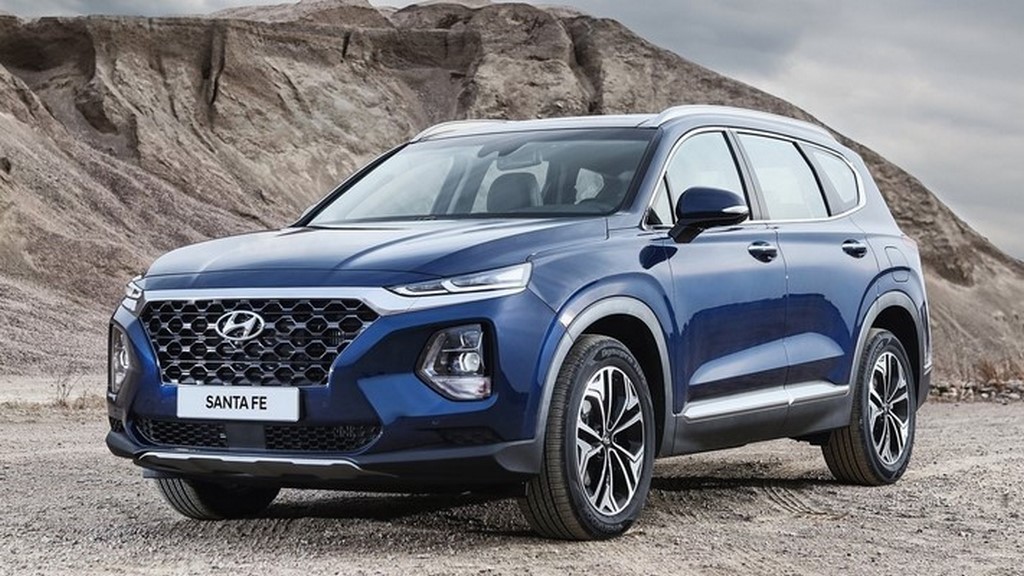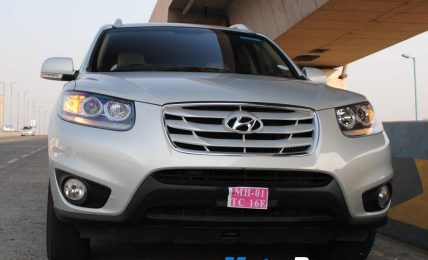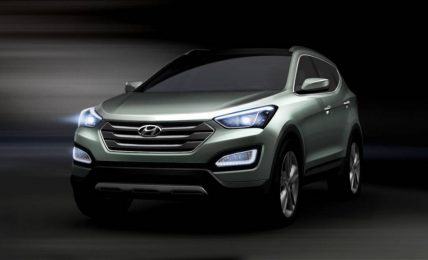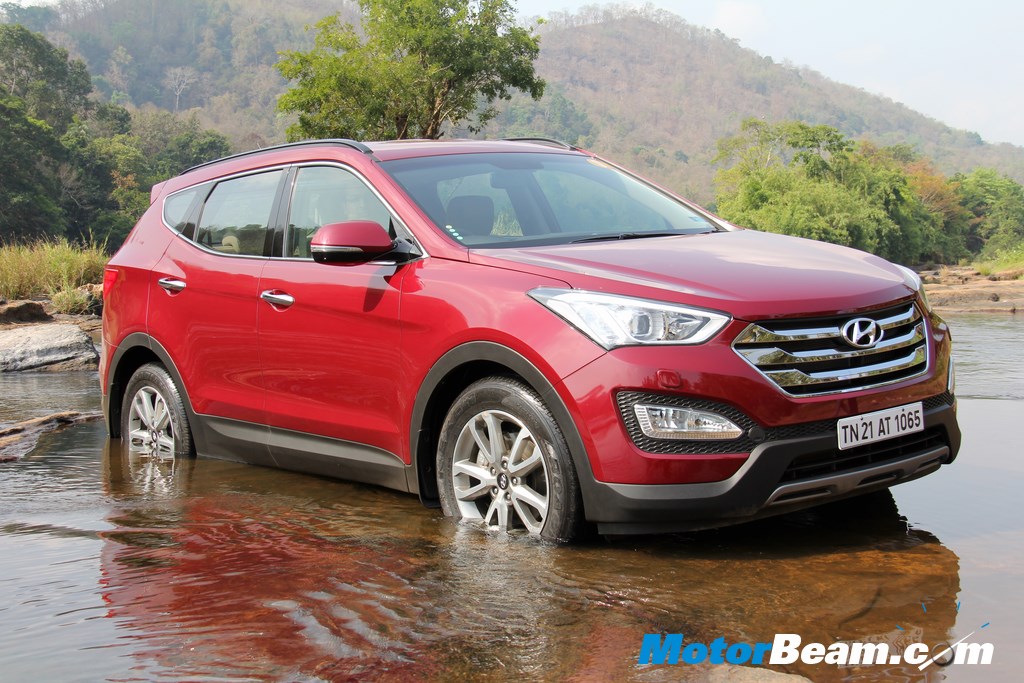
2014 Hyundai Santa Fe Review
Car Tested: 2014 Hyundai Santa Fe
Price OTR Mumbai: Rs. 30.81 – 34.24 lakhs
The third generation Hyundai Santa Fe not only looks spectacular but is highly capable.
Hyundai has lately been on a product offensive and the Korean manufacturer has been busy churning out new models in quick succession. The first launch of 2014 from the Seoul based manufacturer is the all new third generation Santa Fe. The Santa Fe began its life in 2001 when it went on sale in the United States. The second generation model came out in 2008 and the same was launched in India in 2010. The latest offering of the Santa Fe (third generation) was launched in India at the 2014 Auto Expo. This third generation Santa Fe combines Hyundai’s Fluidic design philosophy with pure muscle and athleticism and looks quite stunning. We take the new Hyundai Santa Fe for a spin and find out how it fares through the thick and thin.
Motor Quest: The Santa Fe nameplate originated from the capital city of the state of New Mexico in the United States where it was first launched in the year 2001. Based on the Hyundai Sonata platform, the Santa Fe became so popular with customers that Hyundai had a tough time catering to demand.
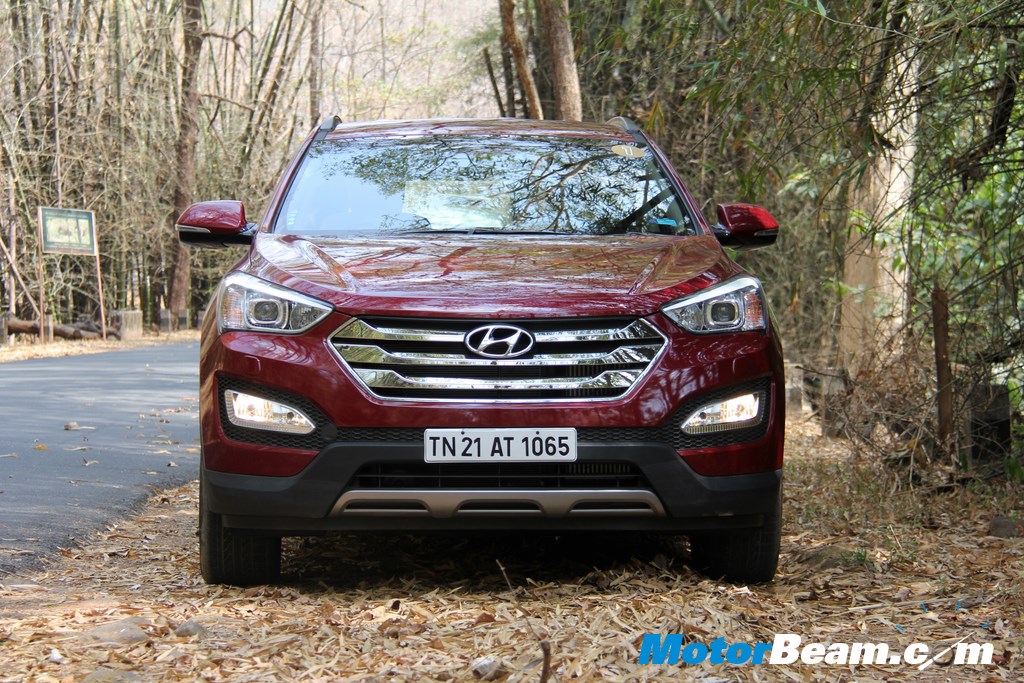
Exteriors – The new Hyundai Santa Fe has undergone a major change and looks the part too. Hyundai has used the ‘Storm Edge’ design concept which captures the powerful moment of the rise and fall of a storm. Embodied in Hyundai’s latest ‘Fluidic Design Sculpture’, the third generation Santa Fe is undoubtedly the best designed car in its segment. It’s now a tad longer than the previous generation car while maintaining the same wheelbase. It is also the most aerodynamic SUV (in the segment) having a coefficient of drag of only 0.34, which has been made possible by redesigning the front bumper lip, wheel reflector and reducing the ground clearance to 185 mm from 200 in the previous generation model. This has lead to a marginal increase in the fuel efficiency too.
The front of the Hyundai Santa Fe is highlighted by the characteristic three bar Hyundai hexagonal chrome front grille, which symbolises the storm edge concept in its lines. The bold and aggressive stance is complemented by the wraparound headlamp design which looks quite attractive with the squarish projector lamps. Headlamp washers ensure there is adequate vision even in slushy conditions. The fog lamps now get cornering function and the overall design looks quite fresh owning to the bold character lines which define the fluidic elements. The black cladding runs all around the car and the dual tone front skid plate shows off its SUV prowess. The width of this new generation model is 10 mm less than the second generation Santa Fe.
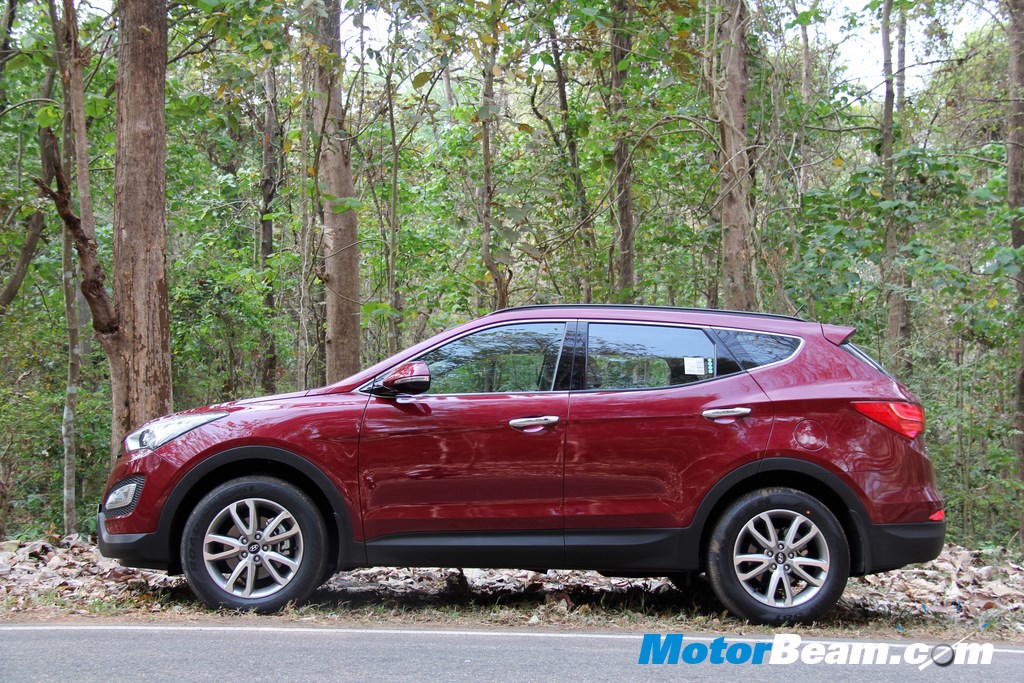
The side profile looks quite fresh and the third generation Hyundai Santa Fe is nothing like the older version. Its design and styling is bound to attract attention in a crowd. The most attractive element on the side is the way the window line swoops upwards to reveal some serious muscle. The chrome surrounds on the windows look classy and the 18-inch, 10-spoke diamond cut alloy wheels add to the premium factor. Roof rails and the rear spoiler make the Santa Fe look quite sporty. The third generation Hyundai Santa Fe is longer by 30 mm over its predecessor and height has now come down by 35 mm.
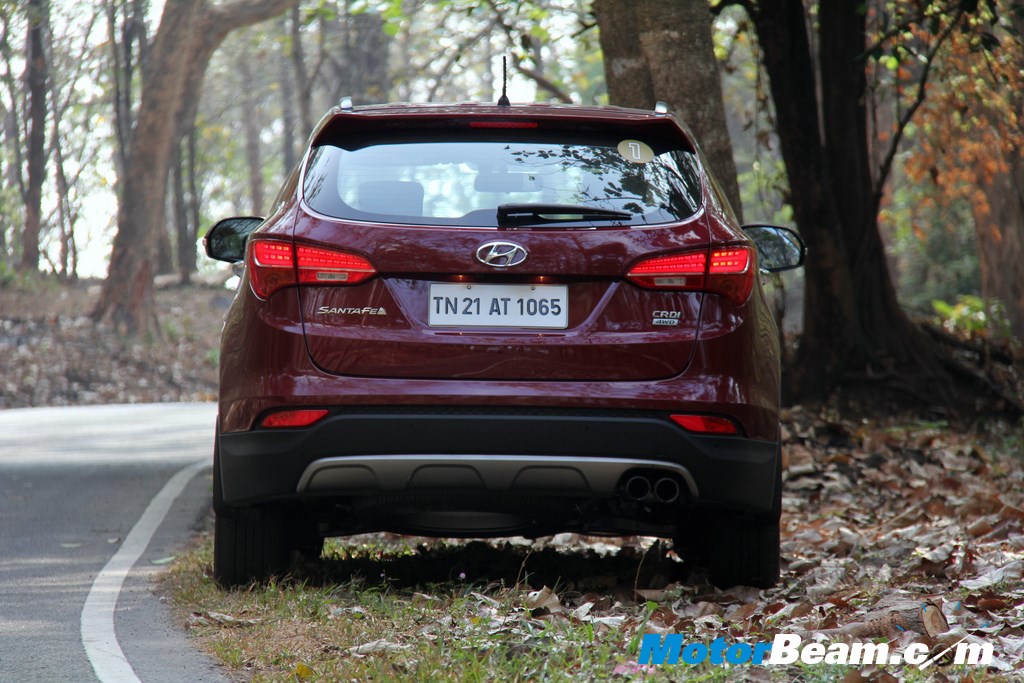
The rear profile is as sporty as the front. The LED combination tail lamps makes it look all the more premium while the rear skid plates below the black cladding add a nice SUV touch. The rear bumper gets reflectors and one has to appreciate how the fluidic design language has completely transformed this SUV. The spare wheel is mounted below as seen in the picture.
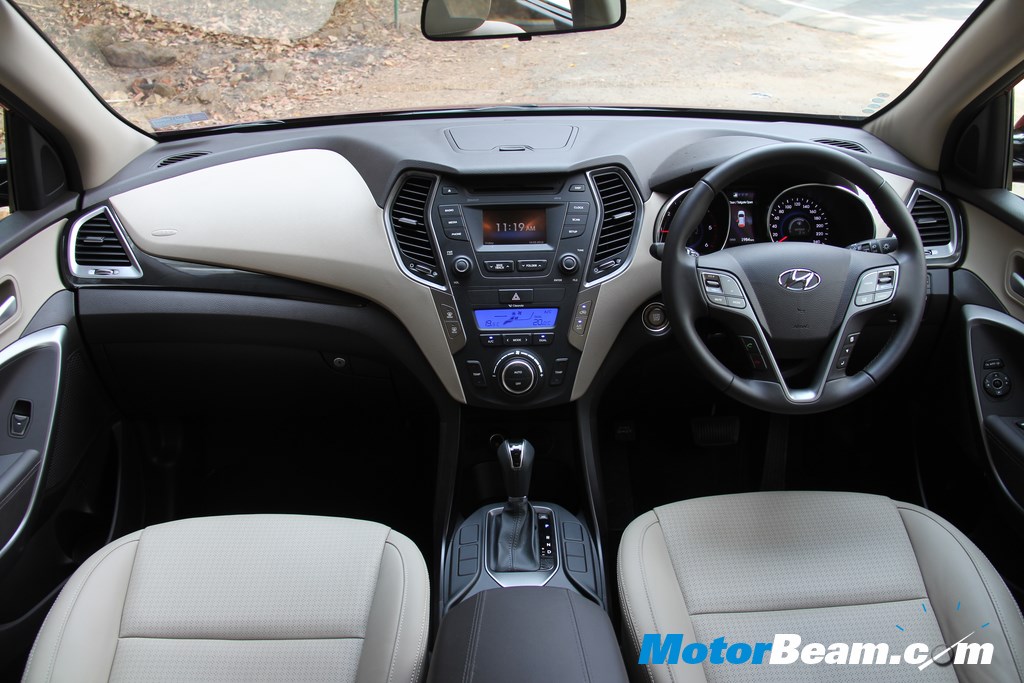
Interiors – Hyundai’s overall interior quality is top notch, be it any segment. The Santa Fe is no different. High quality interiors with precision fit and finish greet you on the inside. The fluidic theme runs in the interiors too with sharp lines and a design which mimics the flowing fluid. The Hyundai Santa Fe gets two tone beige and brown interiors with silver inserts around the AC vents and door trims. The interiors do feel quite premium and are clearly ahead of the the ones offered by the competition. Everything has been thought off well with great attention to detail. The controls are ergonomically placed and everything is easily accessible. There are enough pockets in the doors and centre console for odds and ends. There are two charging points at the front too.
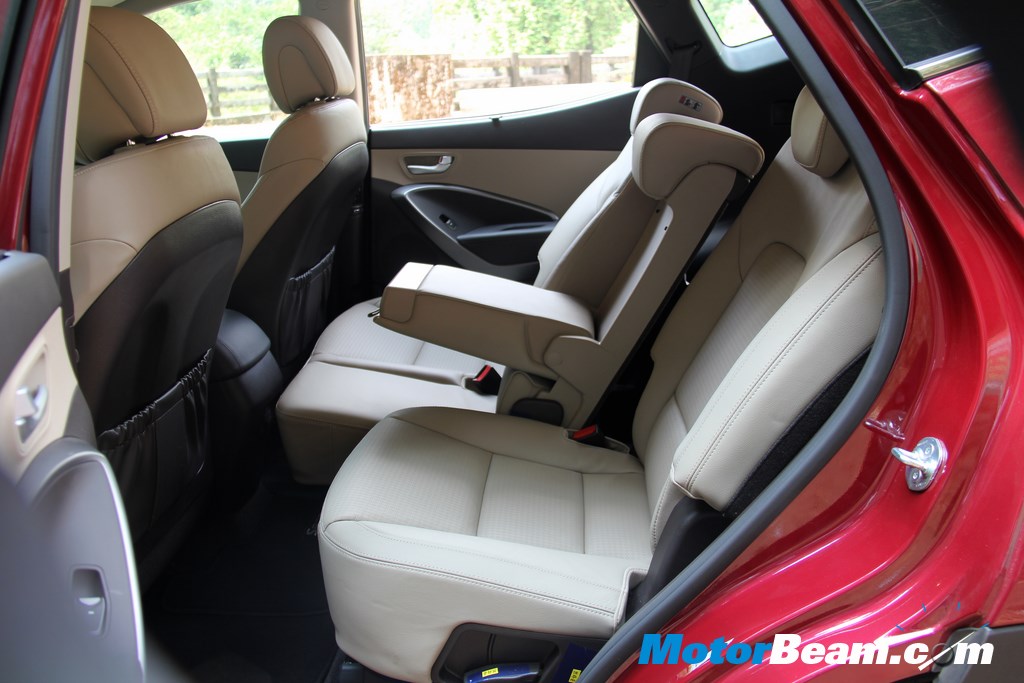
The leather seats are quite comfortable and there is ample legroom and headroom for both the front and middle rows. The middle row has a large range of travel making the seating very versatile. The middle row can be slid forward to get more legroom for the last row of passengers but thigh support at the last row is quite poor, making it ideal only for kids. The front seats offer sufficient amount of lateral support too. The driver’s seat gets 12-way electronic adjustment feature but the front passenger seat gets manual adjustment only. The last row seats fold absolutely flat to reveal a huge boot. With the seats in position, the boot can still hold two medium sized suitcases (vertically side by side). The seats can be folded and unfolded by a switch of a lever and it’s very easy to do so even from the third row. The second row seats fold in a convenient 40:20:40 layout making it more versatile from the luggage point of view.
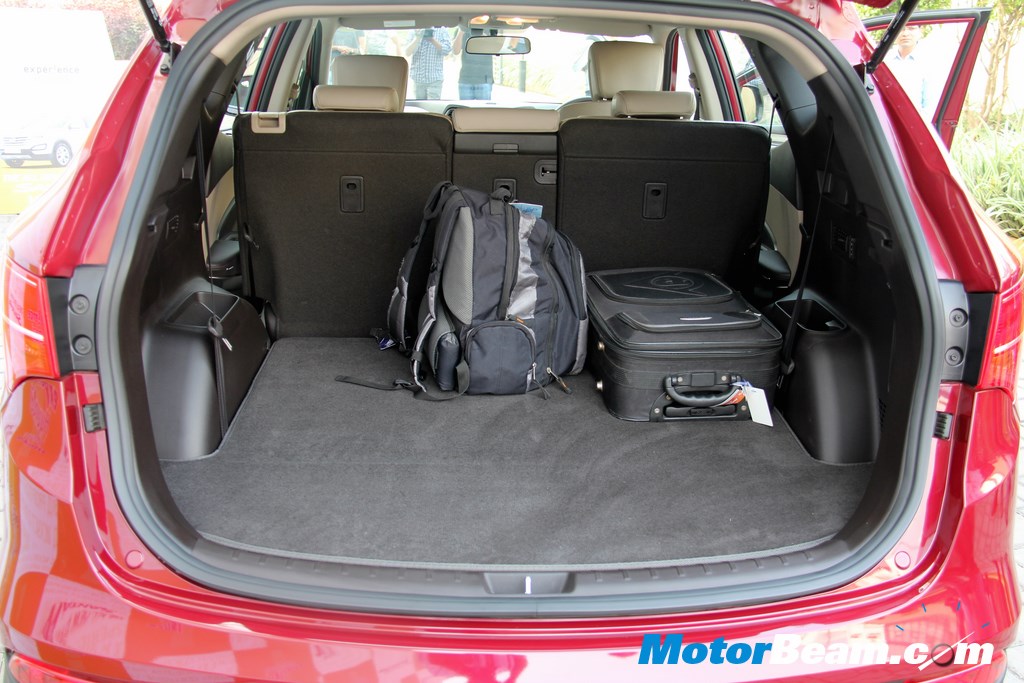
The AC is quite effective as we realised in a hot and humid Cochin. The dual zone AC gets vents on the ‘B’ and ‘C’ pillars respectively for the the middle and third row passengers. The third row passengers also get fan speed adjustment. The audio unit churns out pretty good quality music with virtual surround sound through the 6 speakers. The 4.3-inch TFT LCD touchscreen interface supports CD, USB, AUX and Bluetooth streaming. Pairing the phone is pretty easy and the multi-functional steering wheel has buttons for audio controls and phone. The instrument cluster is easy to read and looks quite modern and stylish. The steering and gear lever get a special leather stitching. There is a foot operated parking brake instead of a regular handbrake.
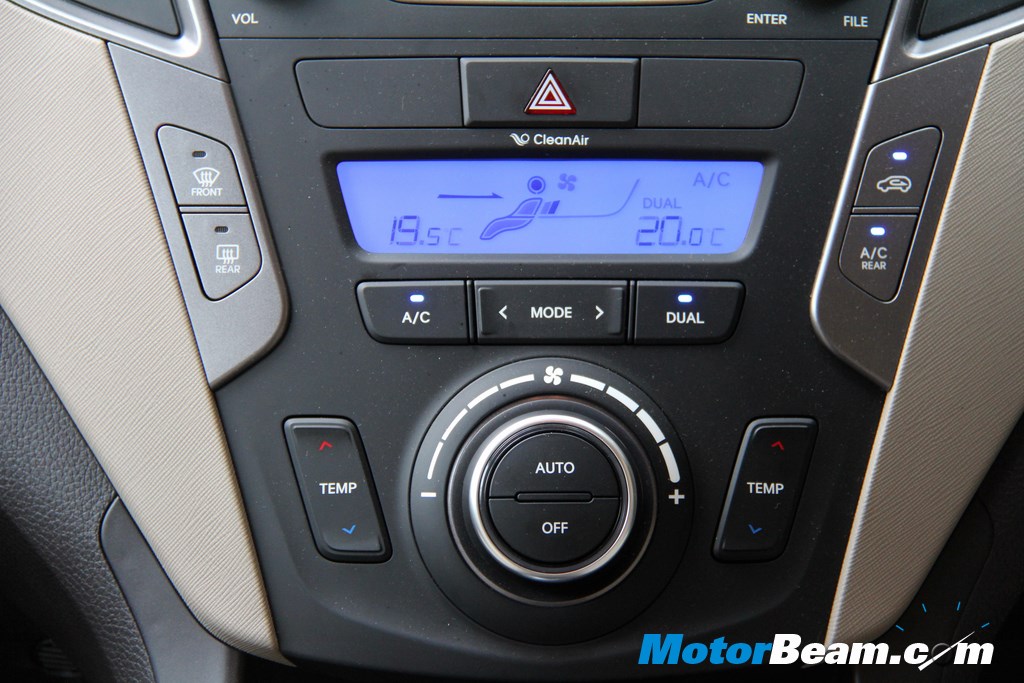
Hyundai cars are feature rich and there is no reason for the Santa Fe to be any different. Besides the regular bells and whistles you expect from a car of this segment, there is more added to the booty. The list includes cruise control, rear parking sensors, rear parking camera, cooled glove box, cluster ionizer (which ensures cleaner air to be circulated inside the car), smart key, push button start, auto folding mirrors, rain sensing wipers, puddle lamps and the list is pretty much endless. There is an Active Eco mode, which once activated, controls vehicle AC output, engine and transmission activity for better fuel efficiency. The Hyundai Santa Fe also gets a ‘Solar Glass’ windshield which prevents UV and infra red rays from entering the cabin, keeping it cooler and protecting the occupants from harmful radiation. You also get rear window curtains (manual). What we missed and what should have been there at this price point is auto dimming mirrors and satellite navigation. Also, the Elantra has spoilt us with ventilated seats and we think it should have been offered on the Santa Fe too, it being the flagship model for Hyundai in India.
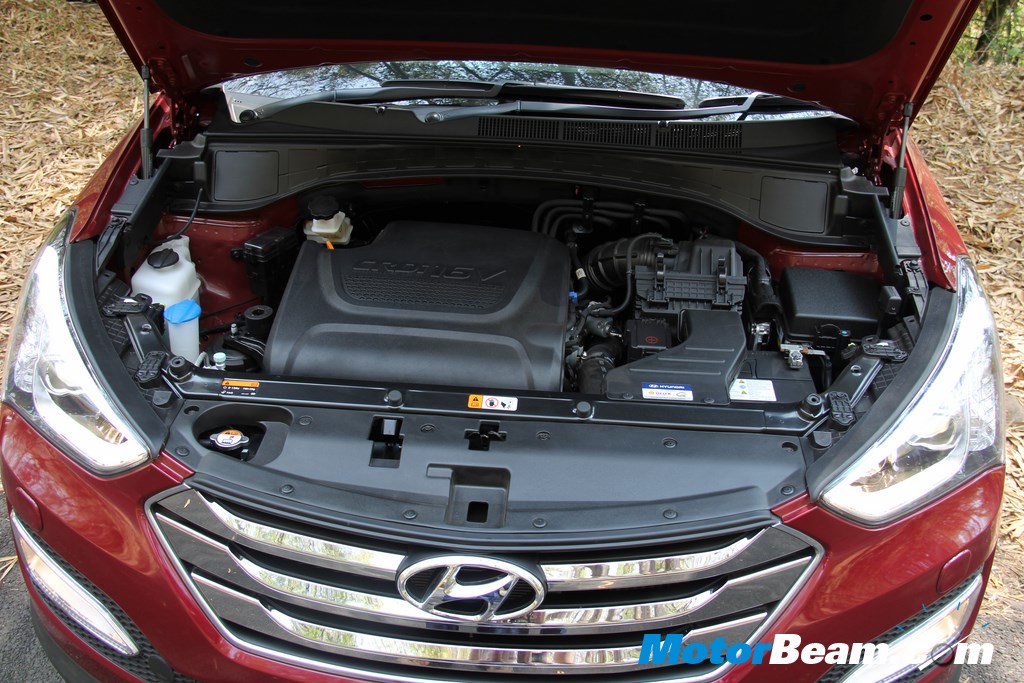
Performance – Powering the Santa Fe is the third generation R-Series 2.2-litre CRDi engine which produces 197 PS of peak power at 3800 RPM and a maximum torque of 420 NM (manual variant) at 1800-2500 RPM. The 4WD Automatic version gets a marginally higher torque rating of 436 NM at 1800-2500 RPM. The new R-Series engine is essentially the same 2.2-litre motor which has been reworked to improve fuel efficiency by reducing friction. The engine operates at 1800 bar pressure which helps in generating high torque at the lower end of the tachometer. The new R-Series also claims to be having better NVH levels than before. Mated to this engine are two transmissions. The 6-speed manual transmission is available only in the 2WD version and offers basic level of kit. Clearly, buyers prefer auto boxes and Hyundai has offered its 6-speed automatic transmission in both 2WD and 4WD trims.
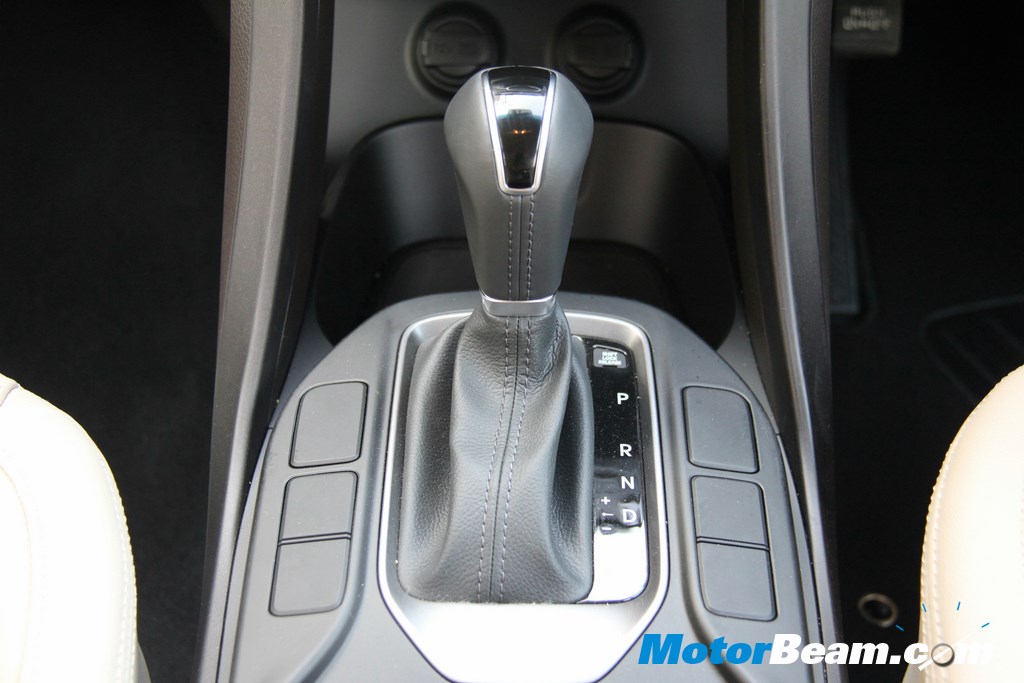
We drove the top of the line 4WD version on the drive. Power delivery from the engine is quite linear and power is available right from the word go, thanks to the electronic variable geometry turbocharger (e-VGT) which makes torque available right from 1800 RPM which means lesser gearshifts in the city thereby improving fuel efficiency. The single clutch autobox is quite slick with shifts with barely any lag for a single clutch transmission but then there are times when you want it to downshift in a jiffy and it does take its own time. There is a manual mode on the gearbox too, in which it will hit the rev limiter before upshifting to the next gear amid some noise. The engine does tend to get a bit noisy around the redline. From an enthusiast’s perspective, the manual would be more fun to drive. All said and done, the Santa Fe sprints to 100 km/hr in less than 10 seconds which is pretty good for a vehicle in this category. The ARAI certified fuel efficiency for the manual and automatic is 14.74 km/l and 13.01 km/l respectively. We reckon the 4WD should return around 9 km/l in the Indian driving cycle.
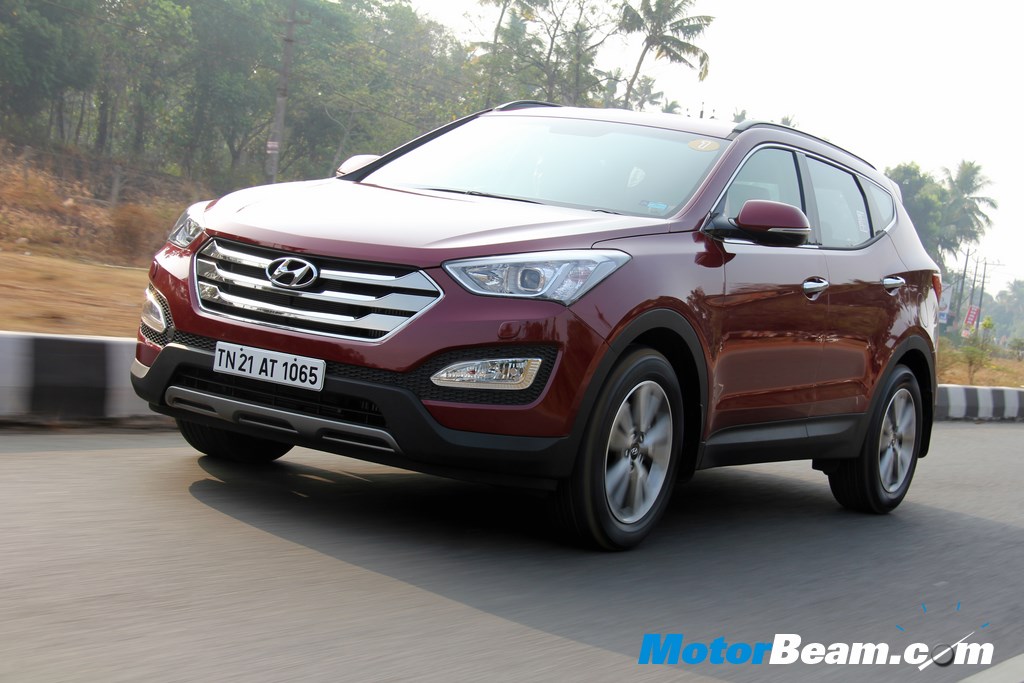
Driving Dynamics – The third generation Santa Fe has improved drastically in the dynamics department. Ride quality is impressive and the all independent multi-link rear suspension acts as sponge to filter out the craters on the road and the result is imminent. Be it a high speeds or low, ride quality remains quite plush. Also vastly improved is the handling. The new Santa Fe has lost close to 125 kgs of weight over the second generation model. This has a big role to play in improved handling. Body roll is there but is now well controlled and within limits. Moreover, you can drive this fast around the twisties and the Santa Fe feels much more surefooted around the corners.
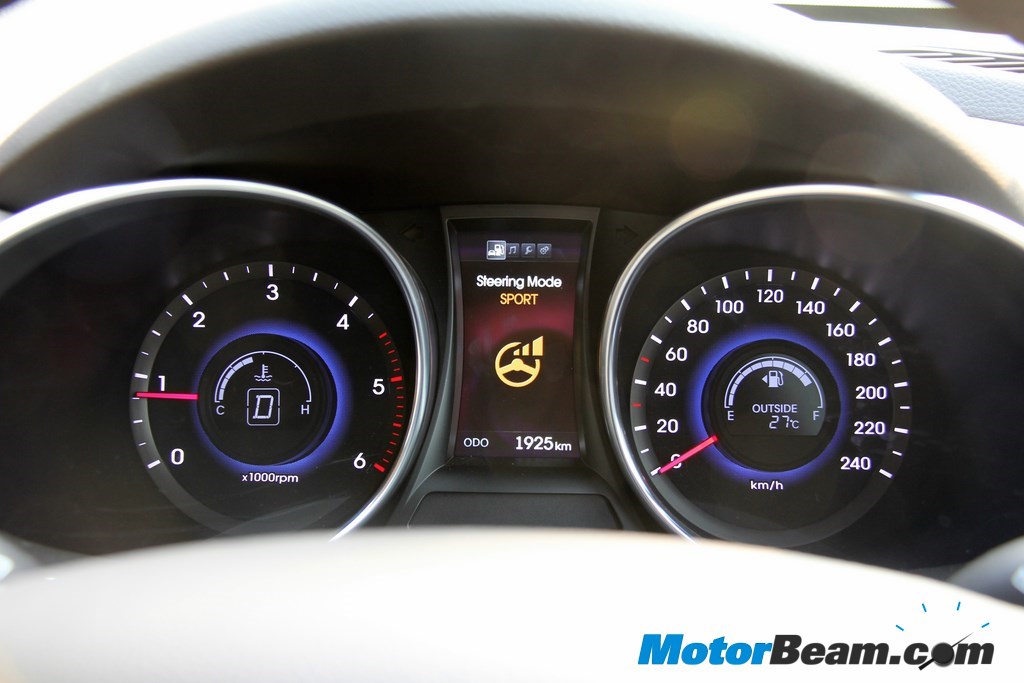
Hyundai has offered what it calls Flex Steering on the this car. There are three modes which can be toggled through a button on the steering wheel. The first, or ‘Comfort’ mode is ideal for city condition where the steering feels extremely light and this mammoth SUV navigates through traffic with ease. Switch to ‘Normal’ mode and the steering weighs up a bit which is suited for both city and highway but feels a little dead at high speeds. Fear not, there is one more mode called ‘Sports’ where the steering electronically weighs up and feels more responsive at high speeds and on the highways. It is more fun around the curves too, however, it still does not give you the same feel as some of the German cars of this caregory, but is still quite responsive.
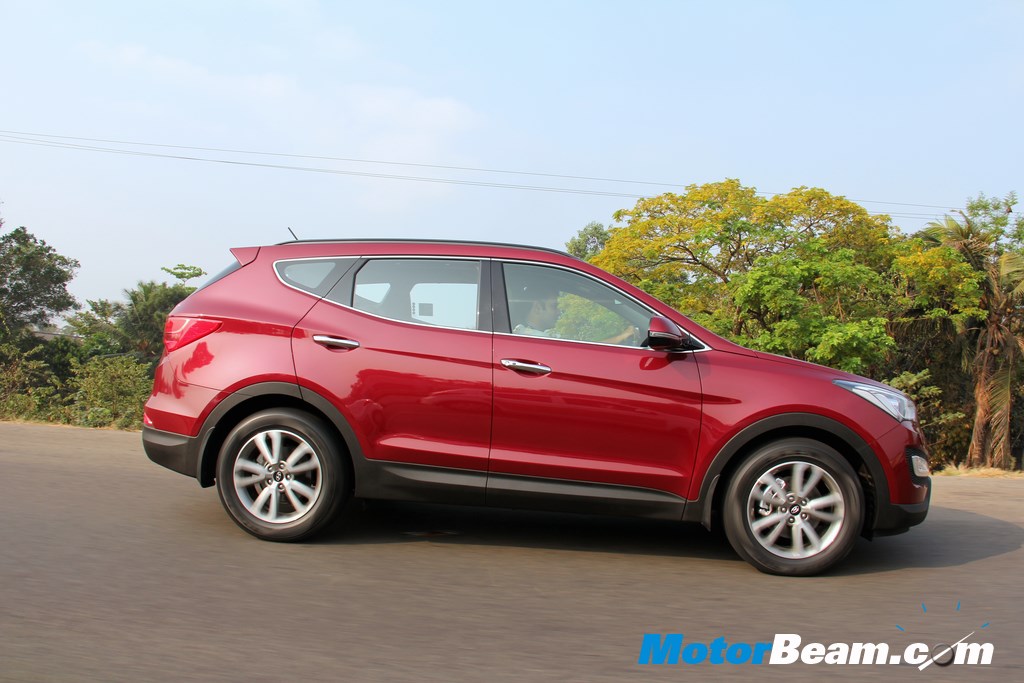
The Santa Fe comes with a lot of electronic aids which help in the braking performace. Equipped with all four disks, the brakes bite well with predicatable stopping power, even from high speeds. To keep things in control, there is Traction Control, Brake Assist, Vehicle Stability Management (which combines the intelligence of the ESP with the power steering to maintain directional stability in case of sudden braking), Electronic Stability Control (which ensures optimal braking performance by automatically delivering the right amount of braking force to each wheel based on engine torque and speed). The Santa Fe also gets Hill Start Assist Control to prevent rollback when on an incline and Downhill Brake Control, which controls the speed of descent in steep situations.
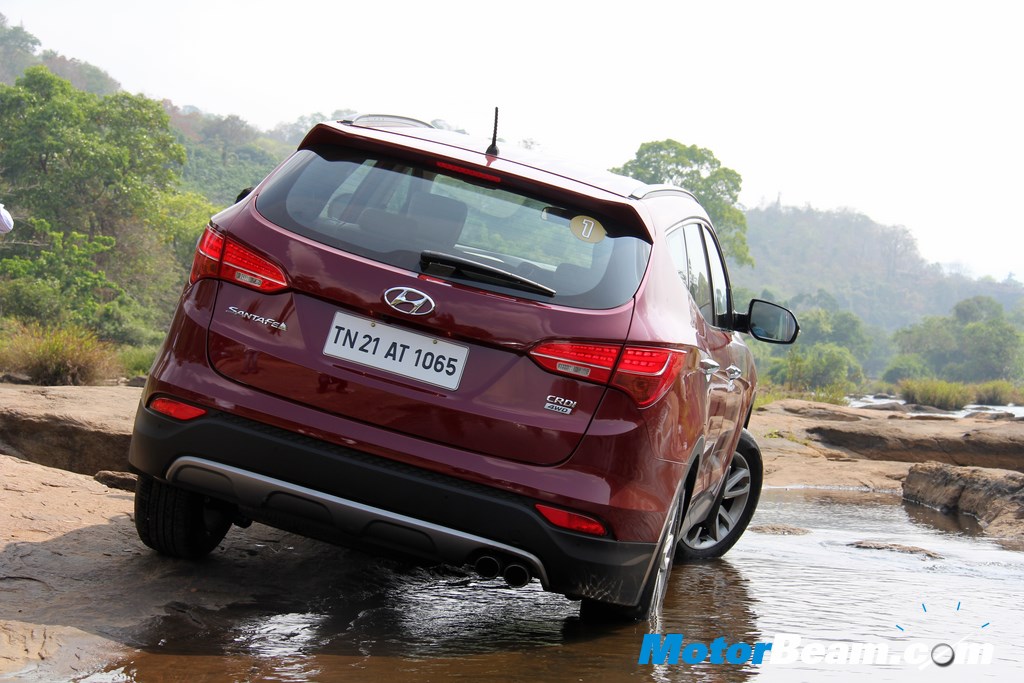
A true SUV is all about off-road capability and the Santa Fe is one highly capable machine. In usual tarmac conditions, the Santa Fe works in front wheel drive mode. When a slip is detected at any of the wheels, it automatically shifts into 4-wheel drive. Moreover, one also has the option of locking the differentials and manually shifting it into permanent four-wheel drive mode by a flick of a button. We tried off-road antics on a river bed, rock and loose mud and it works absolutely perfectly, well almost. When the Santa Fe was conceived, it was targeted at an urban buyer, someone who wants off-road capability but seldom uses it. Keeping this in mind and to keep it extremely aerodynamic, Hyundai had to opt for a very conservative approach and departure angle. Which essentially means, that on steep inclines and declines, there is a chance it will kiss its underbelly. Which should not be a problem courtesy of the skid plates. Besides this point, the Santa Fe’s off-road capability is truly astonishing.
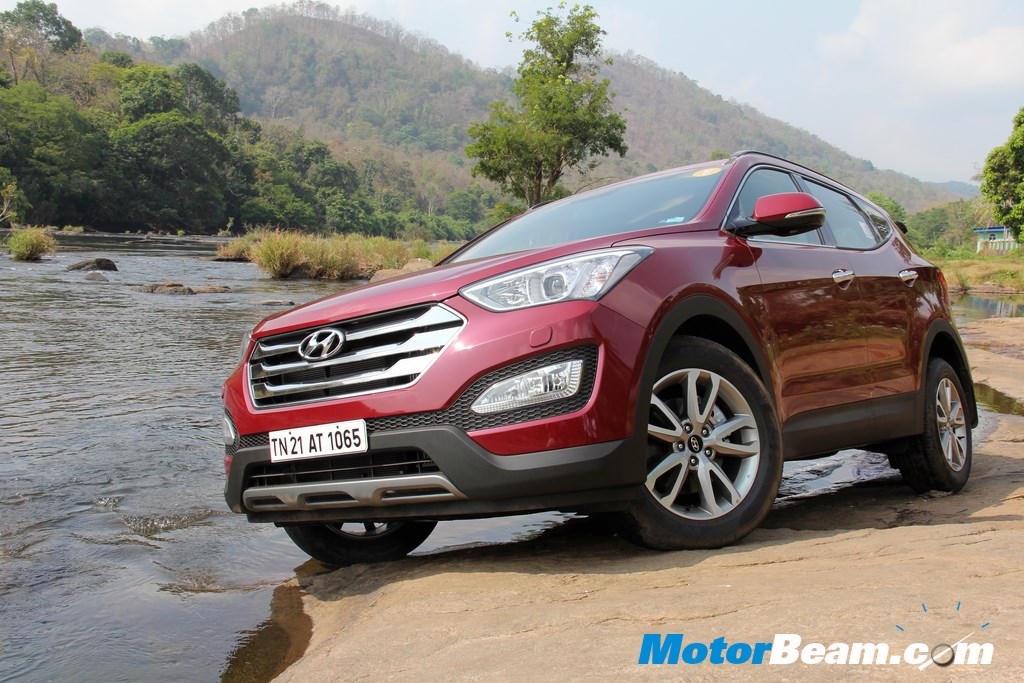
Verdict – The new third generation Santa Fe is a great product and impresses in each and every department. The fluidic design makes it look quite sporty and the comfortable and luxurious interiors will appeal to most. The large list of features on offer and abundant safety features are more than enough to have anyone convinced. Besides, its true SUV character is bound to impress the off-road junkie. Hyundai is offering a 3-year, 1-lakh kilometer warranty with service intervals at 10,000 kms. It is also superior to its Japanese rival in every respect but does it have the goods to find many takers? As a product, definitely yes but there is a catch. Hyundai has priced it quite optimisticly and that could be a turn off factor for many. But the Santa Fe is Hyundai’s flagship model in the country and it’s all about the pride. The pride of getting one up on the Japanese and a fitting reply it is, that the Koreans are closing in and mean serious business.
The new Santa Fe raises the bar yet again and is a far superior product than its Japanese rival. As Hyundai’s flagship model, it excels in each and every department but comes at a price.
What’s Cool
* New fluidic design
* Off-road capability
* Improved dynamics
What’s Not So Cool
* No auto dimming mirrors
* No satellite navigation
* Overly expensive
Alternatives: Toyota Fortuner, SsangYong Rexton, Mitsubishi Pajero
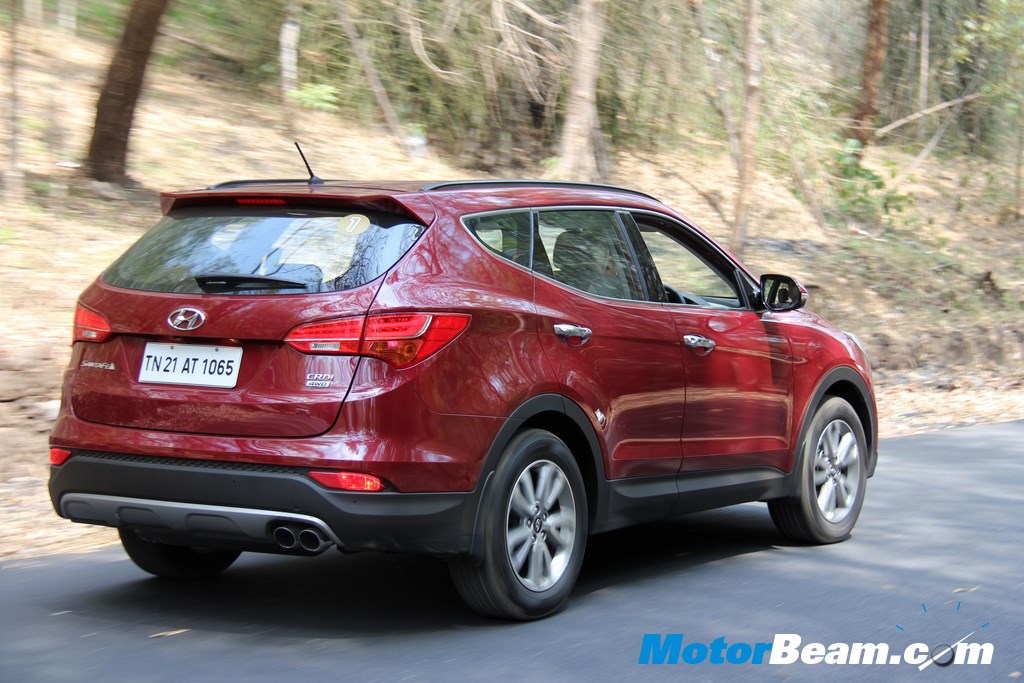
2014 Hyundai Santa Fe Specifications
* Engine: 2199cc, third generation ‘R’ series CRDI
* Power: 197 HP @ 3800 RPM
* Torque: 436 NM @ 1800-2500 RPM (4WD); 420 NM @ 1800-2500 RPM (2WD)
* Transmission: 6 speed manual (2WD); 6 speed automatic (2WD, 4WD)
* 0-100 km/hr: 8.76 seconds (4WD)
* Top Speed: 180 km/hr (est.)
* Fuel Consumption: 7-9 km/l (real world)
* Fuel Type: Diesel
* Suspension: McPherson Struts (Front), Multi-link Independent Suspension (Rear)
* Tyres: 235/60/18 Silica tyres
* Brakes: Ventilated Disc (Front), Disc (Rear)
* Safety: ABS, TCS, BAS, VSM, ESC, HAC, DBC, 6 Airbags, Park Distance Control
2014 Hyundai Santa Fe Dimensions
* Overall length x width x height: 4690 mm X 1880 mm X 1690 mm
* Wheelbase: 2700 mm
* Ground clearance: 185 mm
* Boot Volume: 585 liters (with last row folded)
* Fuel Tank Capacity: 64 litres
* Kerb Weight: 1862 kgs


